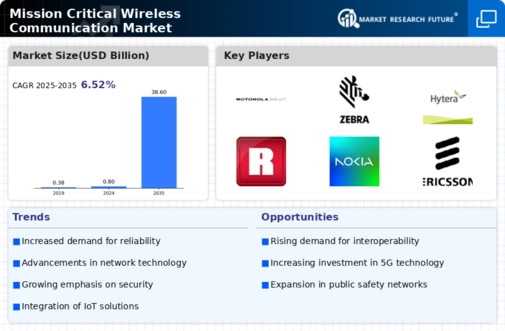Emergence of Private Networks
The emergence of private networks is reshaping the landscape of the Mission Critical Wireless Communication Market. Organizations are increasingly opting for private wireless networks to ensure secure and reliable communication tailored to their specific needs. This trend is particularly evident in sectors such as utilities, transportation, and manufacturing, where operational continuity is paramount. The shift towards private networks is projected to account for a significant portion of market growth, with estimates suggesting that they could represent over 40% of the total market share by 2030. This shift underscores the importance of customized communication solutions in mission-critical environments.
Advancements in Wireless Technologies
Technological advancements are playing a pivotal role in shaping the Mission Critical Wireless Communication Market. Innovations such as 5G technology and the Internet of Things (IoT) are enhancing the capabilities of wireless communication systems. These advancements enable faster data transmission, lower latency, and improved connectivity, which are essential for mission-critical applications. The integration of these technologies is expected to drive market growth, with estimates suggesting that the adoption of 5G could lead to a 30% increase in efficiency for emergency response teams. As organizations seek to leverage these advancements, the market is likely to witness significant transformation.
Regulatory Support and Standardization
Regulatory support and standardization are crucial factors influencing the Mission Critical Wireless Communication Market. Governments and regulatory bodies are increasingly recognizing the need for standardized communication protocols to ensure interoperability among various agencies. This is particularly relevant in emergency response situations, where seamless communication can save lives. Recent initiatives have been launched to establish guidelines and standards that promote the use of mission-critical communication systems. Such regulatory frameworks not only enhance safety but also encourage investment in advanced communication technologies, thereby propelling market growth.
Growing Focus on Public Safety Initiatives
The emphasis on public safety initiatives is significantly impacting the Mission Critical Wireless Communication Market. As urbanization increases, the need for effective communication systems in public safety operations becomes more pronounced. Law enforcement agencies, fire departments, and emergency medical services are prioritizing investments in mission-critical communication solutions to enhance their operational efficiency. Data indicates that spending on public safety communication systems is expected to rise by 15% in the coming years, reflecting a growing recognition of the importance of reliable communication in safeguarding communities.
Increasing Demand for Reliable Communication
The Mission Critical Wireless Communication Market is experiencing a surge in demand for reliable communication systems. This demand is primarily driven by the need for uninterrupted communication in emergency services, public safety, and defense sectors. As incidents of natural disasters and security threats rise, organizations are increasingly investing in robust communication solutions. According to recent data, the market is projected to grow at a compound annual growth rate of approximately 12% over the next five years. This growth indicates a strong recognition of the importance of dependable communication systems in mission-critical scenarios, where failure is not an option.


















Leave a Comment